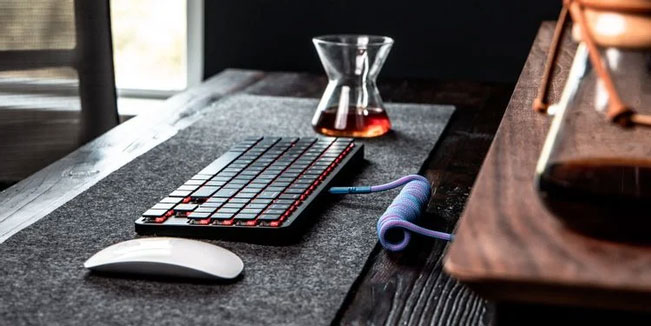Do you love the feel of typing on a mechanical keyboard but dislike the clacking noise it makes? Try these 6 tips to help reduce the noise of your mechanical keyboard.
Methods to Reduce Noise When Typing on a Mechanical Keyboard
Any moving object produces sound, and your keyboard is no exception. Unfortunately, there is no mechanical keyboard that is completely silent, and the noise level depends on the key’s actuation force.
There are several ways to help reduce the noise of your mechanical keyboard, especially if the clacking sound bothers those around you while gaming or working in an office setting. While it may not completely eliminate the noise, it can certainly minimize it significantly.
If you’re ready, let’s explore why mechanical keyboards are so noisy and how to quiet them down!

There is a switch beneath each keycap.
Why Do Mechanical Keyboards Make So Much Noise?
The source of the clacking noise from mechanical keyboards primarily stems from their mechanical design. Beneath each keycap is a switch that transmits the force from your finger down to a spring, activating the electronic circuit. This force transmission creates noise, but it is also how the keyboard inputs data into the system.
Over years of use, the switches beneath the keycaps can become stiffer, producing louder sounds due to friction, or your mechanical keyboard may have been noisy right from the start. Regardless of the cause, this clacking can be quite annoying for those unaccustomed to it.
Now that you know why mechanical keyboards are so loud, let’s get to work on “quieter” solutions!
1. Change Your Desk Surface

The position of your keyboard can contribute to the clacking sound.
The surface where you place your keyboard can act as an amplifier or sound dampener. Using an old desk with many grooves can cause your mechanical keyboard to produce louder sounds than usual. Switching to a smoother surface will make a noticeable difference.
The position of the keyboard also influences the clacking sound. Typically, the force from your fingers is transmitted to the spring inside the switch beneath the keycap and continues to the surface below. When the keyboard is placed on an uneven surface, the force may not dissipate fully, amplifying the clacking noise. Similarly, placing the keyboard on your lap will produce louder sounds compared to placing it on a desk.
Therefore, check the flatness of your keyboard’s surface and consider changing it if possible. Alternatively, a desk pad can be an effective solution if you cannot change your workspace.
2. Use a Desk Pad

A desk pad can help absorb the impact of keystrokes before they hit the desk.
You probably have a mouse pad nearby. Try placing your keyboard on it and typing. Notice how much quieter it is? If you find it satisfactory, consider purchasing a desk pad.
When typing, the force is transmitted to the desk surface. The movements caused by this force create vibrations that amplify the sound. Therefore, you should try to absorb as much impact as possible before it hits the desk, and a desk pad will help with that.
There are many desk pad products on the market from various brands, available in different sizes and materials.
If after changing your desk surface and using a desk pad the clacking sound is still too loud for you, it might be time to disassemble your keyboard and make some adjustments.
3. Use O-Ring Dampeners
O-Ring dampeners are typically installed around the keycap to reduce sound resonance. On a keyboard, they are used to minimize noise when pressing the keys.
First, you need to remove all the keycaps, then install an O-Ring on each switch beneath, and finally, reattach the keycaps. The dampeners will help reduce the noise produced with each keystroke, making your mechanical keyboard quieter.
However, using this method will significantly affect the key feel, and spending a considerable amount on a mechanical keyboard may feel pointless. Additionally, depending on how often you use the keyboard, the dampeners may wear out quickly, requiring frequent replacements.
So, if you’re okay with these downsides, feel free to use O-Rings. Otherwise, consider other tips!
4. Add Foam Inside the Keyboard
Adding foam can help reduce noise generated from inside your keyboard. This is a relatively simple and low-cost method to reduce the noise of a mechanical keyboard. The only downside is that it can be quite time-consuming to install. You can easily remove the plastic clips or disassemble the keyboard to place the foam between the bottom case and the printed circuit board (PCB).
Sobrathane and Neoprene are two common materials used for foam. Sobrathane provides better noise reduction but will make your keyboard heavier. On the other hand, Neoprene is lighter and cheaper but less effective at noise reduction compared to Sobrathane.
You can also use the packing foam that came with your keyboard if you’re on a budget. If you’ve discarded the keyboard’s packaging, you can temporarily use a drawer liner as a substitute. Although these two makeshift solutions are cost-free, their effectiveness may not be substantial.
5. Lubricate the Switches
This is another effective way to reduce noise, but it requires considerable preparation time. Lubricants help reduce friction between the spring and the slider inside each switch.
You will need to remove each keycap, then take out each switch to apply the lubricant and reassemble them, which can be quite time-consuming, so this is not an immediate fix. However, if you have the time, this method is worth trying.
Additionally, be careful not to apply too much lubricant as it can reduce the key’s responsiveness. Some keys may also not function properly. Finally, ensure that the lubricant you choose is safe for plastic. Only attempt this solution if you fully understand what you’re doing.
6. Get a New Keyboard or Build Your Own
If you still can’t reduce the noise to an acceptable level after trying all five methods above, it may be time to give up on this keyboard. Instead, consider switching to a new keyboard with a longer key travel instead of one with high responsiveness. And if you’re a mechanical keyboard enthusiast, you might even consider building your own keyboard.
You can purchase the case, keycaps, and switches separately to assemble it in your desired configuration, allowing you to create a super quiet mechanical keyboard that won’t disturb those around you.
We hope these tips can help make your mechanical keyboard quieter. If you’re not handy, avoid trying the tips that require disassembling keyboard parts. And if anything goes wrong while you tinker, don’t worry, you can always take it to a technician for repairs.


















































